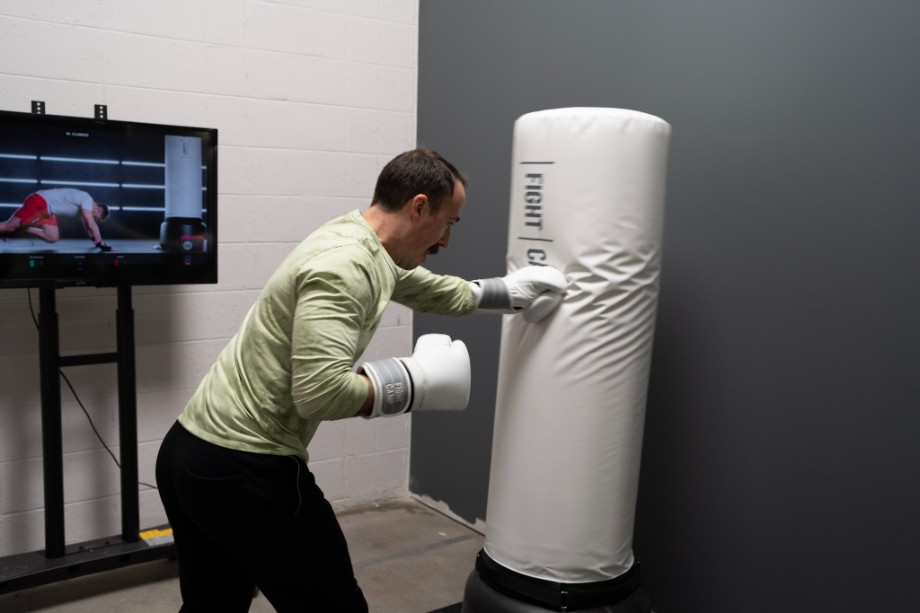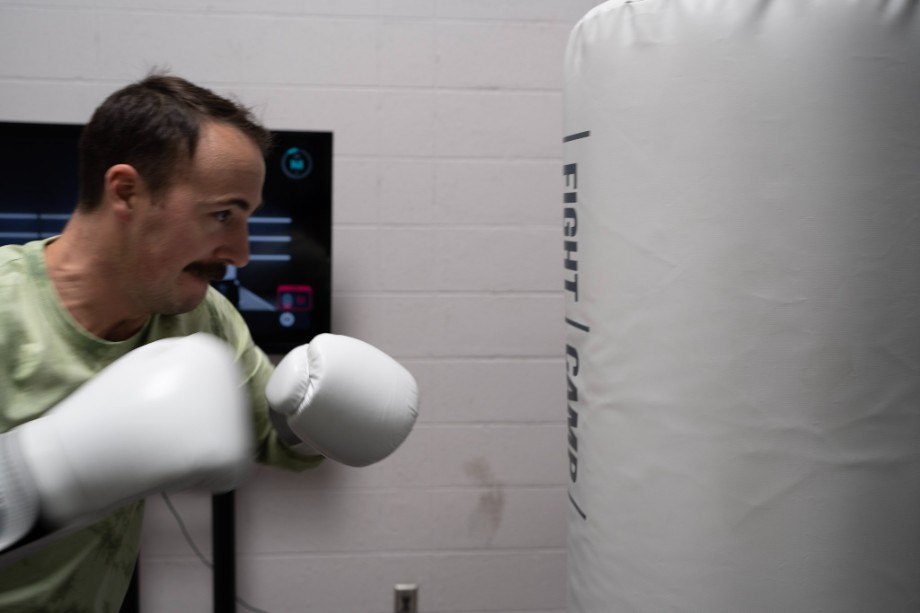We test and review fitness products based on an independent, multi-point methodology. If you use our links to purchase something, we may earn a commission. Read our disclosures.
There are countless ways to break a sweat and get in a great workout. One of the more interesting trends we’ve seen in recent years is the rise of boxing as a HIIT workout.
I’m not talking about combat boxing, which has always been popular, but boxing for fitness. More gyms are offering boxing and kickboxing for cardio classes, and I’ve even started to see boxing clubs open—not for those who want to fight, but for those looking to improve their health.
Should you ditch your gym membership (or leave your garage gym) to go join a boxing club, or is this just another trend? As a certified fitness coach and someone who’s spent years training in a variety of martial arts, I’m going to share the most important health benefits of boxing, and explain how to get started if you want to give it a try.
What is Boxing?
Before we dig in, let’s be clear about what we’re talking about. When someone mentions boxing, you might picture Mike Tyson or Muhammad Ali lacing up the gloves and exchanging punches in a ring.

While this is the sport of boxing, non-contact boxing for fitness often takes a slightly different approach. Yes, there may be light sparring with others, but boxing classes often focus on footwork, mobility, and punching a bag or a training pad held by a partner. Even if you join a gym that focuses on competitive boxing, you shouldn’t be trying to knock each other out in training; you’re there for a great cardio workout.
RELATED: Best Cardiovascular Exercises
Some gyms even use boxing as part of a fitness class, mixing in other activities like jumping rope, push-ups, squats, and more, and may have workout equipment right next to the punching bags.
If you’re not interested in joining a gym, putting on some boxing gloves and hitting a punching bag in your garage can still provide a great workout. You don’t need a special boxing club or membership to enjoy the benefits, and even beginners can have a great time.
Fitness boxing is similar to other forms of HIIT training. Rounds are usually limited to several minutes, your heart rate gets quite high, and you need to rest and recover between rounds. It won’t replace long-distance, steady-state cardio, but it can be a great way to spice up your training with intervals.
Health Benefits of Boxing
Aside from the pure enjoyment many receive from punching something, as well as the self-confidence boost from learning how to throw a bunch, regular boxing can provide many health benefits. Let’s look at some of the most important ones.
Improves Cardiovascular Health
If you’ve never tried boxing, know that it’s much harder than it looks. Putting on a pair of heavy gloves, staying light on your feet, and throwing punches at a heavy bag will quickly have you gasping for breath as your heart rate increases. It’s a great form of cardiovascular exercise.

RELATED: Steady-State Cardio vs HIIT
This study1 compared high-intensity boxing training to brisk walking in adults with obesity over 12 weeks. The boxing group improved their blood pressure and VO2 max, and reduced their body fat percentage. The walking group didn’t experience any significant health improvements.
That doesn’t mean walking is bad or unhealthy, but it highlights the powerful health benefits of high-intensity boxing classes.
Improves Hand-Eye Coordination
The first time you try boxing, you may feel quite clumsy and uncoordinated. I really struggled to balance proper punching technique with footwork, mobility, and breathing when I started.
As with anything, you should get better with practice. One thing that certainly improves is your hand-eye coordination, which can help improve your performance in all sorts of activities and hobbies.

A 2020 study2 tested hand-eye coordination, movement reaction time, and tactile sensitivity in a variety of athletes, including basketball players, football players, combat sports athletes (like boxers), and more. The combat sports athletes had the greatest tactile sensitivity, meaning they had the most control over their grip and hand strength. They also had the shortest reaction time and fewest errors in a motor coordination test.
Provides a Full-Body Workout
Many forms of cardiovascular and HIIT training only focus on one muscle group. Sprinting engages the lower body, and battle ropes challenge the upper body. Cycling can work both the legs and arms on something like an air bike, but you’re still sitting.
Boxing is one of the few HIIT workouts that engages your entire body. You’re standing, twisting and turning, and moving on your feet. You may even have to duck and move your head to dodge a punch if you’re sparring with a partner. Engaging your whole body generally provides a more challenging workout and saves time compared to training everything individually.
Improves Balance
Unless you want to stand still and make yourself an easy target, boxing generally involves moving in different directions, often shifting your weight from foot to foot and bouncing around. This isn’t guaranteed to make you fall-proof, but it’s a great way to improve your balance.

I couldn’t find any research looking at boxing’s impact on balance in healthy populations, but this 2024 review3 looked at the effects of boxing exercises in individuals with Parkinson’s disease, a neurological disorder that impacts motor control. The study found that boxing significantly improved both balance and quality of life.
May Improve Mental Health
Along with the physical benefits, boxing can be a great way to blow off steam and relieve stress. We’ve long known that exercise can relieve stress, but this 2023 study4 went a step further, looking specifically at the mental health impacts of non-contact boxing classes.
According to the study authors, “Non-contact boxing exercises, usually in a high-intensity-interval training group setting, provided significant reduction in symptoms of anxiety, depression, PTSD and negative symptoms of schizophrenia. Non-contact boxing provided a cathartic release of anger and stress, with evidence of improved mood, self-esteem, confidence, concentration, metabolic burden, strength and coordination.”
In other words, if you’re not feeling quite right, putting on some gloves and getting in a boxing workout is a great way to boost your mood.

RELATED: Exercise for Anger: Can Working Out Help You Cool Down?
Is Boxing Dangerous?
Most of this article focused on non-contact boxing, or boxing classes with very light partner sparring. You may still be wondering if boxing classes are dangerous. If you’re particularly adventurous, you may be considering stepping into the ring to see how you fare in an actual boxing match.
Proper boxing is not without risk, which makes sense, as the goal is to punch each other repeatedly. A 2023 meta-analysis5 looked at the incidence rate of boxing-specific injuries. Researchers found that while injury rates have declined over the years, the risk hasn’t gone away.
The most common injuries are soft tissue contusions to the face, or bruising, along with facial cuts. More seriously, boxing can cause concussions or serious neurological problems.

Our advice? If health and safety is your biggest concern, stick to non-contact boxing workouts to enjoy all of the benefits without taking a punch to the face.
How to Start Boxing
While it’s tempting to grab a punching bag and gloves and start swinging away, there are a few things you may want to consider before trying a boxing class.
The following tips will ensure you get the most of your workouts, and avoid hurting yourself unnecessarily in the process.
- Try a local class at a boxing gym. If you’re new to boxing, getting started with hands-on instruction and a supportive community is a great way to try it out, especially if you like the social aspect of group fitness. Not to mention, you’ll probably be able to rent a pair of gloves and try it out before purchasing anything yourself.
- Hire a boxing coach. If group fitness isn’t your thing, you should still consider hiring a coach to learn how to throw a proper punch. If you don’t use the proper technique, it’s easy to cause serious injury to your hands or wrists. Make sure you understand how to safely punch a heavy bag.
- Use a boxing app. If you’ve got a bag, gloves, and know how to throw a punch, you still need a workout plan. Many fitness apps may include boxing workouts, or you can try something like FightCamp, a smart home gym system that focuses on boxing.
- Try shadow boxing. Shadow boxing refers to simulating boxing with your bare hands—no gloves or punching bags required. If you’re new to boxing and don’t have any equipment, shadow boxing is a good way to practice the movements with no equipment required.

RELATED: 8 Best Online Workout Programs
Benefits of Boxing: Final Thoughts
If you’re tired of boring cardio and want a fun, stress-relieving way to boost your aerobic fitness, non-contact boxing is a great form of exercise to try. You’ll improve your health, balance, and hand-eye coordination while enjoying some stress relief and improving your mental well-being. If you join a boxing club, you may find yourself a great new social community.
Boxing may seem intimidating, but non-contact boxing classes allow you to enjoy all the benefits without worrying about someone throwing a jab at your head. This is a great choice for anyone who wants to try a new form of HIIT training and have plenty of fun along the way.
Benefits of Boxing: FAQs
Does boxing reduce belly fat?
Boxing is a powerful way to burn calories and get in a great workout. When paired with a proper nutrition plan, this can lead to a reduction in belly fat over time. However, boxing alone isn’t guaranteed to reduce fat.
RELATED: Cardio vs Weights for Weight Loss
Can boxing get you in shape?
Yes, boxing can improve your fitness levels, especially your balance, coordination, and cardiovascular health. Body composition is heavily influenced by your nutrition, but boxing is a fantastic workout to get in better shape. Those who want to build muscle and full-body strength should also include some sort of strength training.
How many times a week should you box?
There’s no hard rule here, and it depends on your goals. If you want to do nothing but box, you can probably train 3 to 5 days a week, as long as you’re recovering well between sessions. If you’re simply looking to use boxing as a cardio workout, you may want to start with fewer weekly sessions as your body adapts to it.
References
- Cheema, B. S., Davies, T. B., Stewart, M., Papalia, S., & Atlantis, E. (2015). The feasibility and effectiveness of high-intensity boxing training versus moderate-intensity brisk walking in adults with abdominal obesity: a pilot study. BMC sports science, medicine & rehabilitation, 7, 3. https://doi.org/10.1186/2052-1847-7-3
- Kaluga, E., Straburzynska-Lupa, A., & Rostkowska, E. (2020). Hand-eye coordination, movement reaction time and hand tactile sensitivity depending on the practiced sports discipline. The Journal of sports medicine and physical fitness, 60(1), 17–25. https://doi.org/10.23736/S0022-4707.19.09726-3
- Chrysagis, N., Trompouki, G., Petropaulis, D., Koumantakis, G. A., Krekoukias, G., Theotokatos, G., Skordilis, E., & Sakellari, V. (2024). Effect of Boxing Exercises on the Functional Ability and Quality of Life of Individuals with Parkinson’s Disease: A Systematic Review. European journal of investigation in health, psychology and education, 14(5), 1295–1310. https://doi.org/10.3390/ejihpe14050085
- Bozdarov, J., Jones, B. D. M., Daskalakis, Z. J., & Husain, M. I. (2022). Boxing as an Intervention in Mental Health: A Scoping Review. American journal of lifestyle medicine, 17(4), 589–600. https://doi.org/10.1177/15598276221124095
- Mao, Y., Zhao, D., Li, J., & Fu, W. (2023). Incidence Rates and Pathology Types of Boxing-Specific Injuries: A Systematic Review and Meta-analysis of Epidemiology Studies in the 21st Century. Orthopaedic journal of sports medicine, 11(3), 23259671221127669. https://doi.org/10.1177/23259671221127669
Further reading

From the front double biceps to the rear lat spread, our bodybuilding poses guide breaks down how to perform each pose, how the judging process works, and more. Read more

Has the Rogue Ohio Power Bar met its match? Check out our full REP Fitness Double Black Diamond Power Bar review and find out! Read more

Looking to knock out some great hamstring exercises at home? Our guide walks you through nine workouts you can do with minimal equipment. Read more

We’ve compiled the best 4th of July treadmill sales so you can be up and running toward your fitness goals without breaking your budget. Read more

